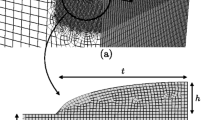Abstract
The objective of the present paper is to propose a strategy to optimize the performance of a Pelton runner based on a parametric model of the bucket geometry, massive particle based numerical simulations and advanced optimization strategies to reduce the dimension of the design problem. The parametric model of the Pelton bucket is based on four bicubic Bézier patches and the number of free parameters is reduced to 21. The numerical simulations are performed using the finite volume particle method, which benefits from a conservative, consistent, arbitrary Lagrangian Eulerian formulation. The resulting design problem is of High-dimension with Expensive Black-box (HEB) performance function. In order to tackle the HEB problem, a preliminary exploration is performed using 2’000 sampled runners geometry provided by a Halton sequence. A cubic multivariate adaptive regression spline surrogate model is built according to the simulated performance of these runners. Moreover, an original clustering approach is proposed to decompose the design problem into four sub-problems of smaller dimensions that can be addressed with more conventional optimization techniques.



















Similar content being viewed by others
References
Anagnostopoulos J S, Papantonis D E (2012) A fast lagrangian simulation method for flow analysis and runner design in pelton turbines. J Hydrodyn Ser B 24(6):930–941. doi:10.1016/S1001-6058(11)60321-1
Andolfatto L (2013) Assistance à l’élaboration de gammes d’assemblage innovantes de structures composites. PhD thesis, École Normale Supérieure de Cachan, France
Ayachit U (2015) The ParaView guide: a parallel visualization application. Kitware
Caniou Y (2012) Global sensitivity analysis for nested and multiscale modelling. PhD thesis, Blaise Pascal University-Clermont II, France
Falcidieno B, Giannini F, Léon J C, Pernot J P (2014) Processing free form objects within a product development process framework. In: Michopoulos J, Rosen D, Paredis C, Vance J (eds) Advances in computers and information in engineering research, ASME. doi:10.1115/1.860328_ch13, (to appear in print)
Friedman J H (1991) Multivariate adaptive regression splines. Annals Stat 19(1):1–67. http://www.jstor.org/stable/2241837
Halton J H (1964) Algorithm 247: radical-inverse quasi-random point sequence. Commun ACM 7(12):701–702. doi:10.1145/355588.365104
Hietel D, Steiner K, Struckmeier J (2000) A finite-volume particle method for compressible flows. Math Models Methods Appl Sci 10:1363–1382. doi:10.1142/S0218202500000604
Iooss B, Boussouf L, Marrel A, Feuillard V (2009) Numerical study of the metamodel validation process. In: First international conference on advances in system simulation, 2009. SIMUL ’09., pp 100–105. doi:10.1109/SIMUL.2009.8
Jahanbakhsh E, Pacot O, Avellan F (2012) Implementation of a parallel SPH-FPM solver for fluid flows. Zetta – Numer Simul Sci Technol 1:16–20
Jahanbakhsh E (2014) Simulation of silt erosion using particle-based methods. PhD thesis, École polytechnique fédérale de Lausanne, no. 6284. doi:10.5075/epfl-thesis-6284
Jahanbakhsh E, Vessaz C, Avellan F (2014) Finite volume particle method for 3-D elasto-plastic solid simulation. In: 9th SPHERIC International Workshop. Paris, pp 356–362
Jahanbakhsh E, Vessaz C, Maertens A, Avellan F (2016) Development of a finite volume particle method for 3-D fluid flow simulations. Comput Methods Appl Mech Eng 298:80–107. doi:10.1016/j.cma.2015.09.013
Joṡt D, MeŻnar P, Lipej A (2010) Numerical prediction of a Pelton turbine efficiency. IOP Confe Ser Earth Environ Sci 12(1). doi:10.1088/1755-1315/12/1/012080
Liou M S (1996) A sequel to AUSM: AUSM+. J Comput Phys 129:364–382. doi:10.1006/jcph.1996.0256
Mack R, Moser W (2002) Numerical investigation of the flow in a Pelton turbine. In: Proceedings of the 21st IAHR symposium on hydraulic machinery and systems. Lausanne, pp 373– 378
Mack R, Gola B, Smertnig M, Wittwer B, Meusburger P (2014) Modernization of vertical pelton turbines with the help of cfd and model testing. In: IOP Conference series: earth and environmental science, vol 22. IOP Publishing, p 012002
Marongiu J C, Leboeuf F, Caro J, Parkinson E (2010) Free surface flows simulations in Pelton turbines using an hybrid SPH-ALE method. J Hydraul Res 48:40–49. doi:10.1080/00221686.2010.9641244
Michálková K, Bastl B (2015) Imposing angle boundary conditions on B-spline/NURBS surfaces. Comput-Aided Des 62(0):1–9. doi:10.1016/j.cad.2014.10.002
Monaghan J J (2005) Smoothed particle hydrodynamics. Reports Progress Phys 68(8):1703–1759. doi:10.1088/0034-4885/68/8/R01
Nestor R M, Basa M, Lastiwka M, Quinlan N J (2009) Extension of the finite volume particle method to viscous flow. J Comput Phys 228(5):1733–1749. doi:10.1016/j.jcp.2008.11.003
Pelton LA (1880) Water-wheel. http://www.google.com/patents/US233692, US Patent 233692
Quinlan N J, Nestor R M (2011) Fast exact evaluation of particle interaction vectors in the finite volume particle method. Meshfree Methods Partial Diff Equas V:219–234. doi:10.1007/978-3-642-16229-9_14
Shan S, Wang G (2010) Survey of modeling and optimization strategies to solve high-dimensional design problems with computationally-expensive black-box functions. Struct Multidiscip Optim 41(2):219–241. doi:10.1007/s00158-009-0420-2
Sobieszczanski-Sobieski J, Haftka R (1997) Multidisciplinary aerospace design optimization: survey of recent developments. Struct Optim 14(1):1–23. doi:10.1007/BF01197554
Solemslie B, Dahlhaug O (2012) A reference Pelton turbine design. In: IOP conference series: earth and environmental science, vol 15. IOP Publishing, p 032005, DOI 10.1088/1755-1315/15/3/032005
Sudret B (2008) Global sensitivity analysis using polynomial chaos expansions. Reliab Eng Syst Safety 93 (7):964–979. doi:10.1016/j.ress.2007.04.002
Vessaz C, Tournier C, Münch C, Avellan F (2013) Design optimization of a 2D blade by means of milling tool path. CIRP J Manuf Sci Technol 6:157–166 . doi:10.1016/j.cirpj.2013.05.002
Vessaz C (2015) Finite particle flow simulation of free jet deviation by rotating Pelton buckets. PhD thesis, École polytechnique fédérale de Lausanne, no 6470. doi:10.5075/epfl-thesis-6470
Vessaz C, Jahanbakhsh E, Avellan F (2015) Flow simulation of jet deviation by rotating pelton buckets using finite volume particle method. J Fluids Eng 137(7):074,501–074,501. doi:10.1115/1.4029839
Xiao Y X, Han F Q, Zhou J L, Kubota T (2007) Numerical prediction of dynamic performance of Pelton turbine. J Hydrodyn Serie B 19:356–364. doi:10.1016/S1001-6058(07)60070-5
Xiao Y X, Cui T, Wang Z W, Yan Z G (2012) Numerical simulation of unsteady free surface flow and dynamic performance for a Pelton turbine. IOP Conf Series: Earth Environ Sci 15(5). doi:10.1088/1755-1315/15/5/052033
żidonis A, Aggidis G A (2015) State of the art in numerical modelling of Pelton turbines. Renew Sustain Energy Rev 45:135–144. doi:10.1016/j.rser.2015.01.037
Author information
Authors and Affiliations
Corresponding author
Rights and permissions
About this article
Cite this article
Vessaz, C., Andolfatto, L., Avellan, F. et al. Toward design optimization of a Pelton turbine runner. Struct Multidisc Optim 55, 37–51 (2017). https://doi.org/10.1007/s00158-016-1465-7
Received:
Revised:
Accepted:
Published:
Issue Date:
DOI: https://doi.org/10.1007/s00158-016-1465-7




